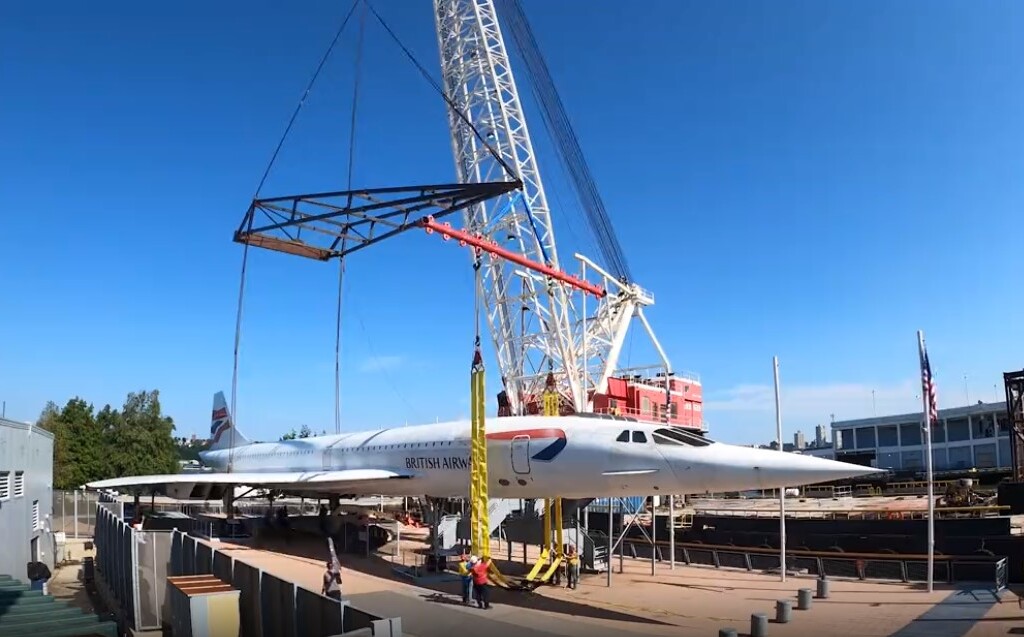Concorde G-BOAD, an aviation marvel renowned for its supersonic speed capabilities, has embarked on a unique voyage that stands in stark contrast to its high speed pedigree.
On Wednesday, the static display aircraft that has graced New York’s Intrepid Sea, Air & Space Museum on Manhattan’s West Side for years underwent a further extraordinary journey – a slow-paced barge trip up the Hudson River.
A Slow-Paced Departure
The fastest Atlantic Ocean crossing by any Concorde occurred on February 7, 1996 and took only 2 hours, 52 minutes and 59 seconds.
In a departure from its usual high-speed feats, the iconic former British Airways Concorde, registered as G-BOAD, embarked on another unique journey. This supersonic passenger airliner, once capable of reaching astonishing speeds of up to Mach 2.02 (1,354 mph), departed on what could be considered its slowest trip ever recorded.
This journey involved carefully removing the Concorde from its static mounts at New York’s Intrepid Sea, Air & Space Museum, where it had been on permanent outdoor display since its retirement in 2003.
The purpose behind this re-location is a significant three-month restoration project at the renowned Brooklyn Navy Yard. The aircraft, steeped in history and an epitome of technological advancement, is set to receive the attention it deserves to ensure its preservation for generations to come.
The Concorde’s Illustrious Legacy
The Concorde’s legacy is one that resonates with the marvel of human engineering and innovation. This supersonic marvel was in service from 1976 to 2003 and holds the distinction of being the fastest commercial aircraft ever constructed.
Capable of achieving speeds that pushed the boundaries of possibility, the Concorde cruised at Mach 2.02, enabling passengers to traverse the skies at an unprecedented pace.
When it was first introduced, the Concorde left the world in awe of its capabilities. Even today, its presence continues to evoke a sense of wonder and admiration. Its sleek design and groundbreaking technology have stood the test of time, making it a timeless sight that reminds us of humanity’s capability to push boundaries.
Exploring the Intrepid Museum Exhibit
New York City’s Intrepid Sea, Air & Space Museum serves as the honored host for Concorde G-BOAD in its static display. A significant piece of aviation history, G-BOAD was the first Concorde to retire from service in 2003.
Now, positioned as a permanent outdoor exhibit, visitors have the unique opportunity to engage with this aviation marvel firsthand.

The museum’s guided tour of G-BOAD takes visitors on a journey through its remarkable interiors. The adventure commences in the cockpit, allowing visitors to immerse themselves in the world of aviation controls and systems. As if stepping back in time, guests can even experience sitting in the pilot’s seat, gaining a firsthand understanding of the aircraft’s operational intricacies.
Continuing the tour, visitors proceed to the cabin, where a glimpse of first-class and economy-class seats await. The cabin’s original condition offers an authentic window into the past, a testament to the elegance and sophistication of air travel during the Concorde’s heyday.
A Tribute to Technological Progress
The Concorde, on display at the Intrepid Museum, holds the esteemed status of being a National Historic Landmark. This honor underscores its significance in shaping the trajectory of commercial aviation and its status as a symbol of technological advancement.
The Concorde’s uniqueness and trailblazing spirit are celebrated through its prominent display, ensuring that its legacy lives on for generations to come.
The Intrepid Museum, however, isn’t solely home to the Concorde. It also houses a diverse collection of aircraft, including a space shuttle, a submarine, and a World War II aircraft carrier. This comprehensive showcase makes the museum an invaluable educational resource, offering insights into both aviation and maritime history.

